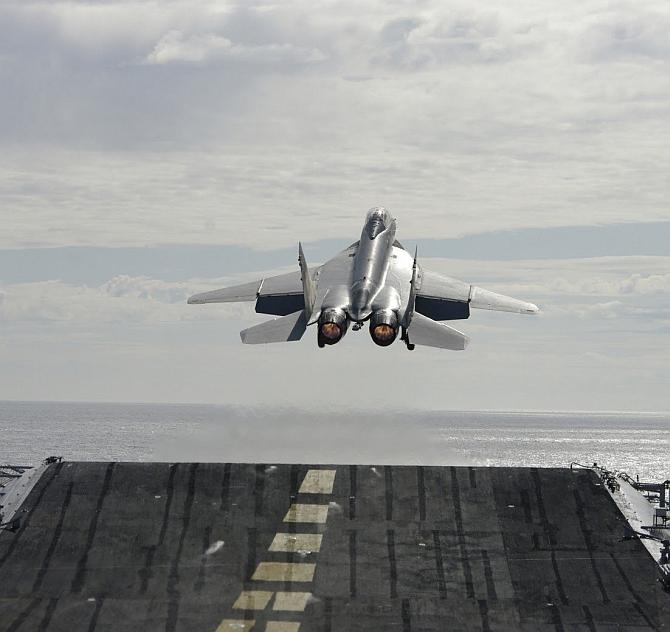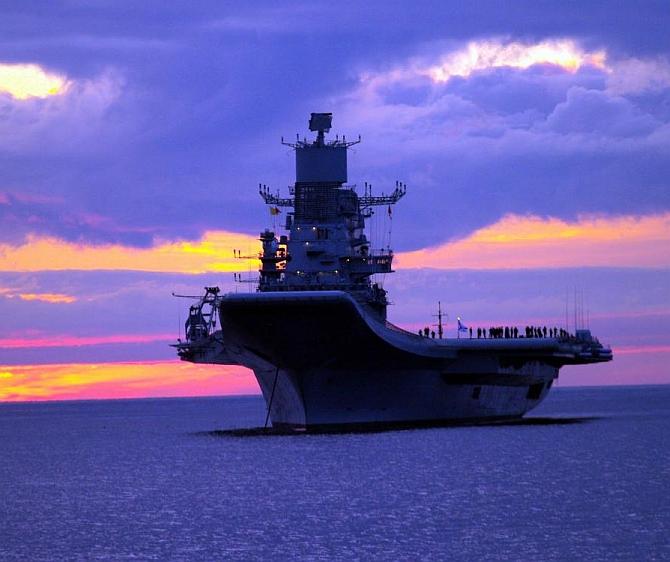The Indian Navy wants 'day and night capable, all weather multi-role deck based combat aircraft which can be used for air defence, air-to-surface operations, buddy refuelling, reconnaissance, electronic warfare missions' from its aircraft carriers.
Ajai Shukla reports.

After declaring that the indigenous Tejas light combat aircraft was not suitable for operations from aircraft carriers, the Indian Navy has declared its interest in buying 'approximately 57' multi-role carrier-borne fighters for deck operations.
The navy's request for information, RFI, posted on the Web on January 25, does not specify whether it wants a single-engine or a twin-engine fighter.
However, the expansive role capability spelt out biases the selection towards a medium-to-heavy, twin-engine fighter.
'The MRCBF are intended as day and night capable, all weather multi-role deck based combat aircraft which can be used for air defence, air-to-surface operations, buddy refuelling, reconnaissance, electronic warfare missions etc from Indian Navy aircraft carriers,' states the RFI.
The RFI specifies that in its operational configuration, the MRCBF would carry four 'beyond visual range' missiles, two 'all-aspect air-to-air missiles' and a gun.
The RFI asks whether the MRCBF is capable of both STOBAR (short take off but arrested recovery) as well as CATOBAR (catapult take off but arrested recovery) aircraft carriers.
The navy's two current carriers -- INS Vikramaditya, which is in service; and INS Vikrant, which is being built at Cochin Shipyard Ltd -- are both STOBAR vessels.
INS Vishal, which would probably be commissioned around 2030, will probably be a CATOBAR carrier.

Theoretically, in the fray are six contemporary fighters.
Three are twin-engine: Dassault's marine Rafale, called the Rafale M; Boeing's F/A-18E/F Super Hornet; and the Russian MiG-29K/KUB.
Another three -- Lockheed Martin's F-35B and F-35C; and Swedish company Saab's Sea Gripen -- are single engine fighters.
The navy has already bought 45 MiG-29K/KUB for its two current carriers and, given the problems with that fighter, will not buy more.
The Rafale M and the Super Hornet are designed for CATOBAR operations, but Boeing officials say computer simulations confirm that the Super Hornet is capable of short take offs from a ski-jump.
"Boeing has completed extensive analysis and done some testing on the F/A-18's compatibility with Indian carriers. We have assessed that the Super Hornet is capable of launching off a ski-jump carrier and could be operated from Indian carriers," says Pratyush Kumar, head of Boeing India.
Meanwhile, development delays could rule out the two F-35 variants -- the vertical take off and landing F-35B and the catapult launched F-35C.
However, Saab officials, speaking off the record, confirm emphatically that they will offer the Sea Gripen.
"We have done detailed feasibility studies that encounter no problem in evolving the Gripen E into a carrier-borne fighter."
Effectively, that places Saab's and Boeing's aircraft in pole position for the MRCBF. Both fighters are also in contention to be built in India to meet the IAF's requirements.

The contours of the race will become clearer on May 24, when original equipment manufacturers must submit responses.
Significantly, the new RFI asks OEMs whether they are willing to manufacture their fighter in India.
Given the timelines for delivery -- with the first fighters to be delivered within three years of contract signature and all 57 delivered within another three years -- the OEMs will find it challenging to establish production in India with an acceptable degree of indigenisation.
"We can establish an assembly facility in India within 18 to 24 months, with about 10 to 15 per cent indigenisation of the fighter. But it would take four years to get 30 per cent indigenisation, and at least seven years to indigenise 45 to 50 per cent of the fighter," says a senior official from one of the OEMs that received the RFI.











